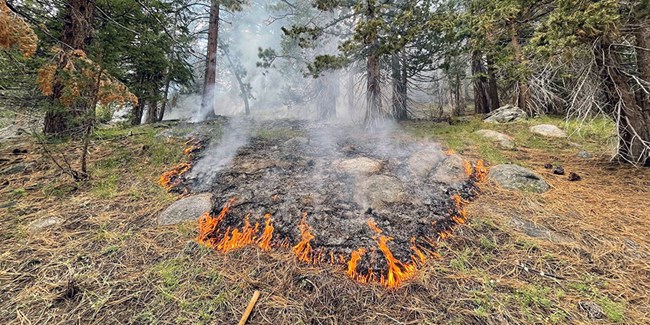Last updated: December 7, 2022
Article
Effective fire management reaps benefits in Yosemite National Park

NPS
Yosemite National Park fire management policy, along with national policies, acknowledge the role wildfires play in in the ecosystem. Wildfire management can provide many benefits to the Yosemite ecosystem, including removing heavy dead and downed vegetation that could burn at high intensities, increasing wildlife habitat diversity and reducing tree density so that forests are more resistant to drought, bark beetles, and subsequent wildfires.

NPS
The Red and Rodgers fires were started by lightning on August 4 and August 8, 2022, respectively, in the remote wilderness of Yosemite National Park. Park management chose to use a strategy to confine and contain the fires using natural barriers such as rocks, trails, and creeks, to minimize the risk to firefighters due to remoteness of the area, as well as steep, rugged terrain. Extreme drought conditions are increasingly common in Yosemite and the surrounding Sierra Nevada with climate change and above average temperatures exacerbating dry fuel conditions.

NPS
Many low-intensity fires over the decades created a forest mosaic that prevents the spread of high-severity wildfire by creating low to moderate fire behavior such as creeping, backing, and single-tree torching during unplanned wildfires. This patchwork promotes different ages and types of trees, increasing habitat diversity, and reducing future risk of catastrophic wildfire.
By the time precipitation quelled both fires, the Red Fire had burned 8,410 acres and the Rodgers Fire had burned 3,131 acres. Both burned at a low to moderate intensity and created a patchwork mosaic which will be a benefit when future wildfires burn in the area. Though the Red Fire burned in the fire footprint of the 2001 Hoover Fire, the areas affected had little to no fire history. Some trail closures were put in place by the park for safety, but as both fires were burning in Wilderness, there were no structures and few visitors affected by the fires.
Yosemite National Park’s fire effects crew monitors, studies, and conducts research to learn about ecological impacts of fire or lack thereof in the forest. By having research such as this, objectives for fire management can be modified and evaluated for safety and success. This ultimately makes Yosemite National Park more fire-resilient for the enjoyment of current and future generations.
